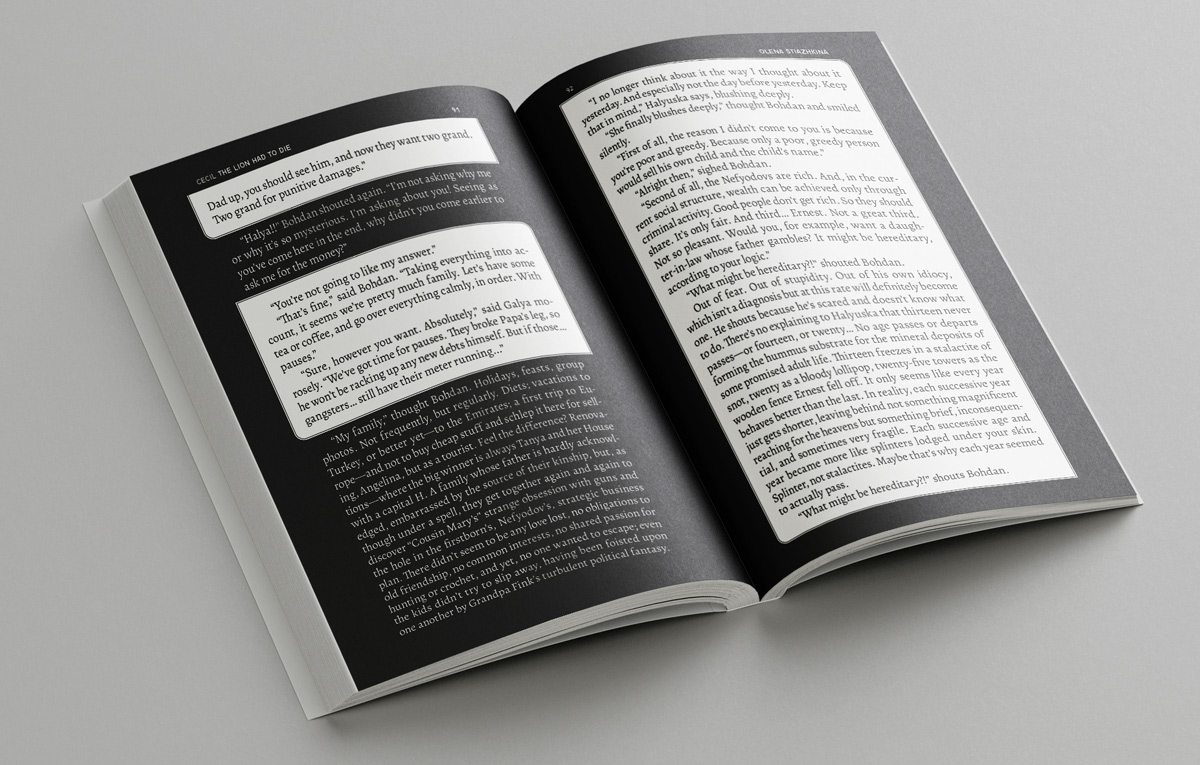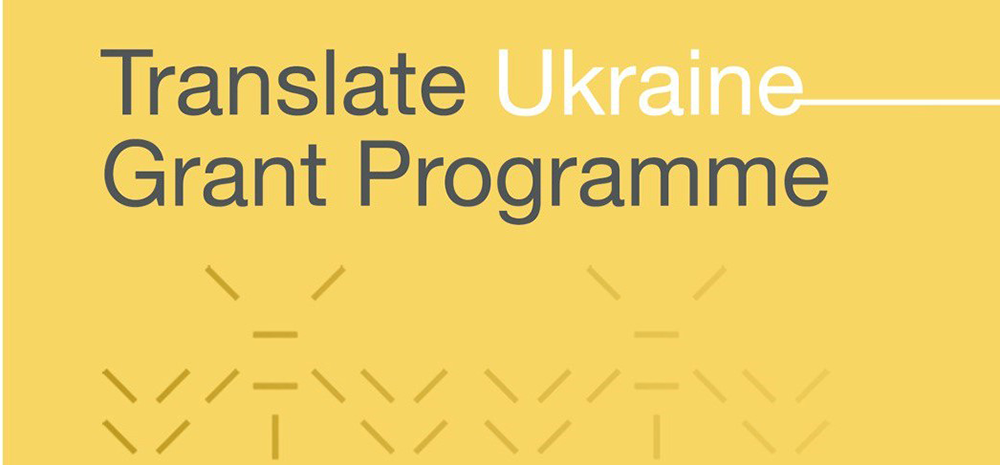* ESC - закрити вікно пошуку
cecil the lion had to die
‘Cecil the Lion Had to Die’: A love so great it intertwines fates
10.05.2024
What is there for people to hold onto when calamity strikes? Most of us hold onto love. For some, love is the highest ideal, a notional god to worship; for others, it is a guiding light in the perpetual darkness of human existence. But faithful, forgiving, and self-sacrificing love is also a commonplace virtue, which has made it one of literature’s most frequent subjects, as in the latest novel by the Ukrainian writer, historian, and publicist Olena Stiazhkina.
An English translation by Dominique Hoffman of “Cecil the Lion Had to Die” is forthcoming from the Harvard Ukrainian Research Institute in print and digital formats in August 2024.
This review highlights what makes the novel essential reading for anyone seeking to understand the realities of life in Ukraine.

Let’s begin by describing the setting. It is impossible to fully appreciate this poignant, sage novel about Donetsk without knowing anything about the history and culture of the region. The author was born in the eponymous capital, rich in minerals and fossil fuel deposits. Donetsk is also the seat of post-Soviet oligarchic wealth and power where Ukraine’s pro-Russian political parties were founded and gained a stronghold. The region began to be settled in the second half of the eighteenth century.
When the Russian Empress Catherine II destroyed the Zaporozhian Sich (Host), which had been their fortress and home base, the now scattered Ukrainian Kozaks sought safety and settled new frontiers. The Kozaks formed Ukraine’s first militia as a self-organized anti-imperial resistance movement, and their leaders headed the first modern Ukrainian (semi-autonomous) state. Thanks to the efforts of the Welshman John Hughes, who built a metallurgical plant in the capital in 1869, that Donetsk later became an economic powerhouse. Russians claim the region, but this undisputed fact makes Russia’s baldfaced lies to justify its more extensive recent annexations of four entire Eastern Ukrainian oblasts, including Donetsk, apparent.
The city of Donetsk is not just the backdrop for the action of the novel but is also one of its main characters. Donetsk has many expressive faces – its weather is in turns hospitably light and aggressively gray – and a rich mythological lore, which Stiazhkina draws from to populate the novel further. The native spirits, like Shubin and Babu, who protect it, for example, “are sad miracles,” or “miracles of the last resort, [in] that final leap to overcome the darkness that doesn’t always work out.”
Donetsk becomes a home to diverse peoples from all over Ukraine and indeed from every corner of the former USSR. Stiazhkina left her native city in 2014 when the Russians first invaded and occupied parts of the region along with a million* other Ukrainians. As the memory of home fades and you even begin to forget the names of the streets in the neighborhoods you played in as a child, you lose an essential part of yourself; when the fictional characters speak in “Cecil the Lion Had to Die” you can hear the voice of the author who shares their pain.
* According to UNHCR, The UN Refugee Agency, there are now nearly 3.7 million internally displaced people in Ukraine and nearly 6.5 million refugees from Ukraine have been recorded globally (as of February 2024).
But all this was preceded by the fateful events of 1986. In front of a birthing center, a man called Fink who was a Soviet official in the Perestroika era [which is called the Perebudova in Ukrainian – Ed.], gathers four couples with their newborn babies who were delivered in the building. Later he will caption the photo with the following dedication: “In honor of the 100th anniversary of the birth of Ernst Thälmann, new mothers in the Lenin District have chosen to name their children after that heroic German Communist viciously murdered by the Fascists in Buchenwald.” The futures of the individuals pictured are so enmeshed it becomes possible to follow up with a posed photograph every ten years. This occurs with some losses…
RELATED: Time, the evil genius, in ‘Forgottenness’ by Tanja Maljartschuk
The structure of Stiazhkina’s novel is a series of interwoven stories about a set of complex characters who demonstrate passionate love, betrayal, friendship, loyalty, courage, valor, endurance, and resourcefulness. Consider Petro and Maria Lischke. Maria is a strong woman and a successful entrepreneur who later becomes a sniper in the Armed Forces of Ukraine. Petro is a gambling addict who works as a transit operator. He is a perpetual dreamer and an idealist whose love for his wife and daughter supersedes all his other responsibilities. Their daughter Haska robs a friend’s family to pay her father’s gambling debts. Alexei Nefyodov dreams of becoming invisible as a boy; he leaves for the front as an adult. His mother Tata (Tanya) is an unrepentant Russophile who all but cheers the arrival of the invading Russian forces, her “competitive” worldview having been formed long before:
“She was looking for genuine envy, a quiet sigh, resentment, she wanted the person who lived in an apartment purchased with her daughter’s name to admit defeat. She wanted everyone to admit that defeat while she, Tanya, celebrated victory.”
Another main character is Bohdan, who has lost a wife to childbirth, leaving him a young widower raising his newborn, Ernst, alone. Bohdan’s child is destined to become a rescuer of abandoned animals in occupied Donetsk, a womanizer and armchair philosopher. Angelina Pohutiak has a wayward daughter, Thälma, who tempts fate and finally disappears from her mother’s life when Angelina gives birth to a second child at 42, whom she names Dina. It is her younger daughter’s destiny to become not only the sole member of the third generation of a large Ukrainian family but its epicenter. Dina represents all her relatives’ love, hope, and faith for lasting peace to emerge in their beloved Donetsk and deep within their depleted souls.

“Cecil the Lion Had to Die” is a novel about cataclysmic socio-political changes. It takes vision, an iron will. and the support of dear friends and loved ones to be left standing when a storm of this magnitude passes. While the book was written before Russia’s ongoing invasion became a full-scale war, it remains particularly relevant to the present moment. In Ukraine, the choice of which language to use has never been a simple “black and white” matter or a binary choice between “right” and “wrong,” as the design of the English translation implies. It is significant that Stiazhkina begins her novel in Russian and concludes it in Ukrainian. Regardless of their past choices, Ukrainians must choose their identity, let go of the past, and look toward the future. Some things are non-negotiable when it comes to ensuring the survival of the Ukrainian nation and its distinct culture.
RELATED: “There is deathly silence around me:” A Review of Nadiya Sukhorukova’s ‘Mariupol Hope’
This review is an invitation to get reacquainted with “Cecil the Lion Had to Die” or to read it for the first time. The ongoing, now full-scale war and the recent translation of the novel into English create new opportunities for readers to ascribe meaning to a nuanced novel. Stiazhkina writes with great sincerity and an unconditional commitment to telling the truth about Donetsk and its inhabitants, who have found themselves stranded, again, in limbo, but have never forgotten who they want to be.
Translation: Lesia Waschuk
Edit: Terra Friedman King
This publication is sponsored by the Chytomo’s Patreon community
що більше читаєш – то ширші можливості

458
Drahomán Prize
Drahomán Prize 2023: The best translators of Ukrainian literature announced
26.04.2024 - Oleksandr Mymruk
543
GRANTS FOR TRANSLATORS
The Ukrainian Book Institute announced an open call for the Translate Ukraine program
17.02.2024 -

